Comparative Analysis of International Employment Relations Systems
VerifiedAdded on 2020/03/16
|10
|2427
|38
Report
AI Summary
This report provides a comprehensive comparative analysis of international employment relations across France, China, and the USA. It delves into the nuances of each country's human resource systems, highlighting differences in training and development investment, reward structures, and employee participation. The report examines the employment relations aspects, including union density, collective bargaining, and worker representation. It also explores the distinct workplace values prevalent in each nation, such as individualism versus collectivism, power distance, and uncertainty avoidance. Furthermore, the report contrasts the remuneration systems, including compensation negotiations, minimum wages, and employee benefits. The conclusion emphasizes the importance of understanding these international differences for multinational companies to implement effective human resource strategies, recommending that strategies align with research findings specific to each country. The report aims to provide insights for managing businesses efficiently across the globe, offering a detailed overview of international employment practices.
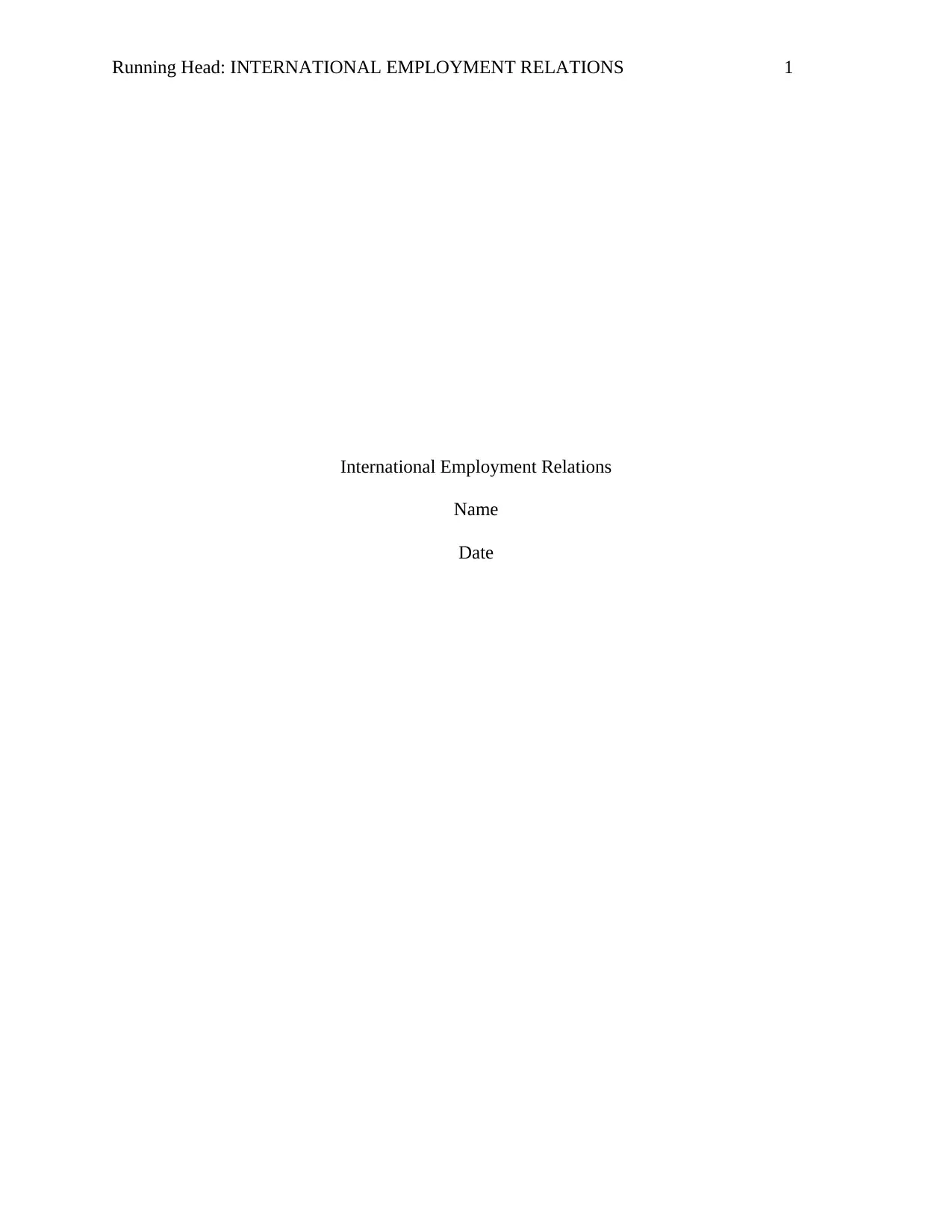
Running Head: INTERNATIONAL EMPLOYMENT RELATIONS 1
International Employment Relations
Name
Date
International Employment Relations
Name
Date
Paraphrase This Document
Need a fresh take? Get an instant paraphrase of this document with our AI Paraphraser
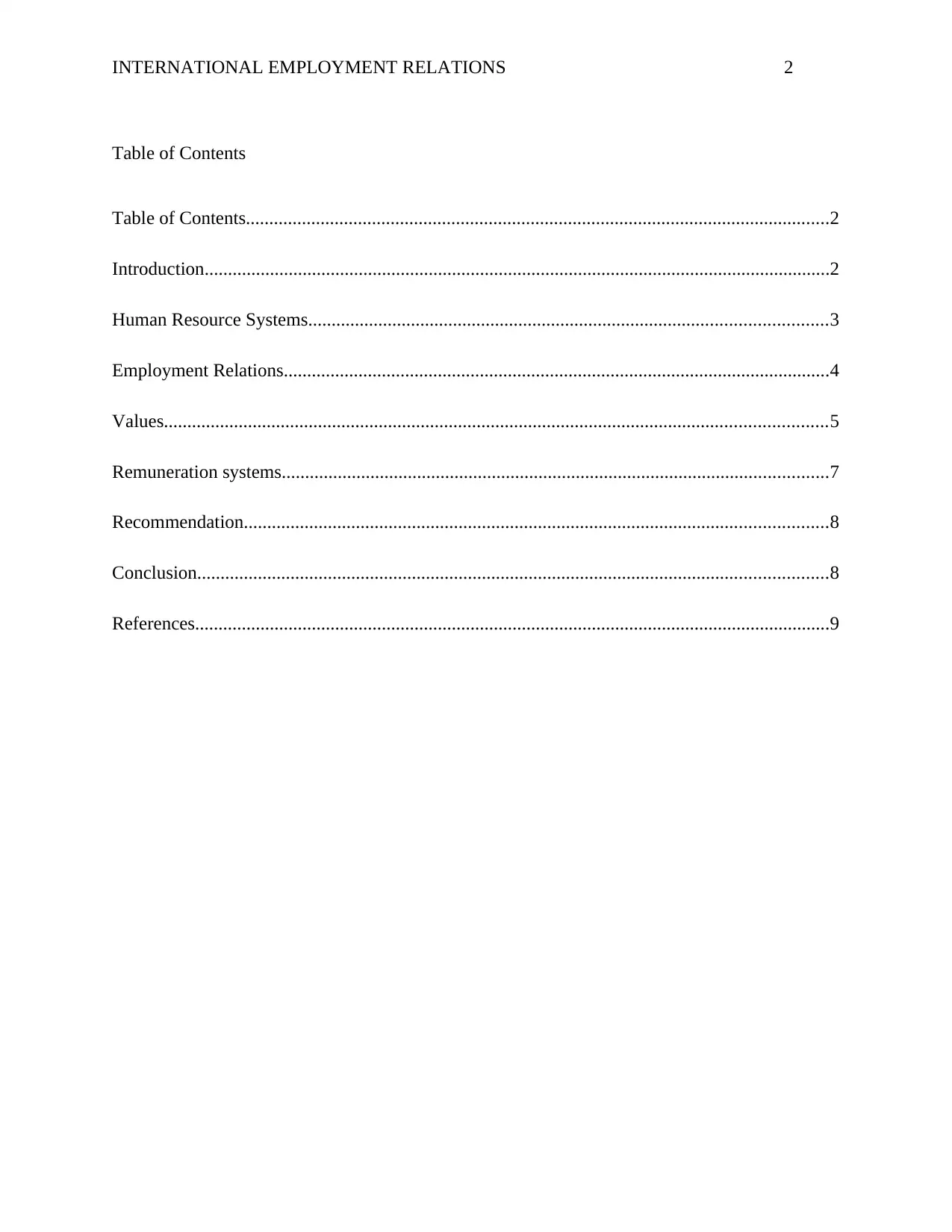
INTERNATIONAL EMPLOYMENT RELATIONS 2
Table of Contents
Table of Contents.............................................................................................................................2
Introduction......................................................................................................................................2
Human Resource Systems...............................................................................................................3
Employment Relations.....................................................................................................................4
Values..............................................................................................................................................5
Remuneration systems.....................................................................................................................7
Recommendation.............................................................................................................................8
Conclusion.......................................................................................................................................8
References........................................................................................................................................9
Table of Contents
Table of Contents.............................................................................................................................2
Introduction......................................................................................................................................2
Human Resource Systems...............................................................................................................3
Employment Relations.....................................................................................................................4
Values..............................................................................................................................................5
Remuneration systems.....................................................................................................................7
Recommendation.............................................................................................................................8
Conclusion.......................................................................................................................................8
References........................................................................................................................................9
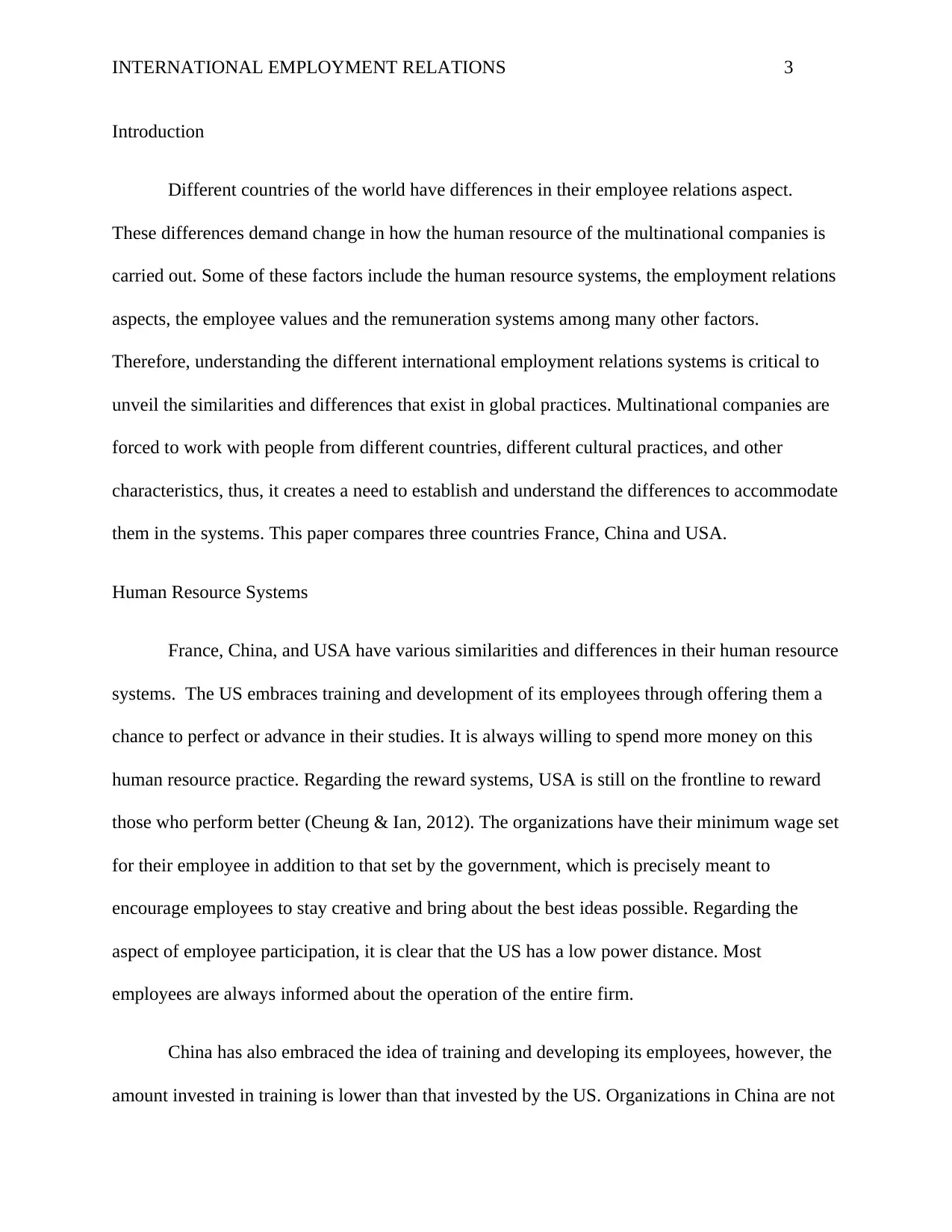
INTERNATIONAL EMPLOYMENT RELATIONS 3
Introduction
Different countries of the world have differences in their employee relations aspect.
These differences demand change in how the human resource of the multinational companies is
carried out. Some of these factors include the human resource systems, the employment relations
aspects, the employee values and the remuneration systems among many other factors.
Therefore, understanding the different international employment relations systems is critical to
unveil the similarities and differences that exist in global practices. Multinational companies are
forced to work with people from different countries, different cultural practices, and other
characteristics, thus, it creates a need to establish and understand the differences to accommodate
them in the systems. This paper compares three countries France, China and USA.
Human Resource Systems
France, China, and USA have various similarities and differences in their human resource
systems. The US embraces training and development of its employees through offering them a
chance to perfect or advance in their studies. It is always willing to spend more money on this
human resource practice. Regarding the reward systems, USA is still on the frontline to reward
those who perform better (Cheung & Ian, 2012). The organizations have their minimum wage set
for their employee in addition to that set by the government, which is precisely meant to
encourage employees to stay creative and bring about the best ideas possible. Regarding the
aspect of employee participation, it is clear that the US has a low power distance. Most
employees are always informed about the operation of the entire firm.
China has also embraced the idea of training and developing its employees, however, the
amount invested in training is lower than that invested by the US. Organizations in China are not
Introduction
Different countries of the world have differences in their employee relations aspect.
These differences demand change in how the human resource of the multinational companies is
carried out. Some of these factors include the human resource systems, the employment relations
aspects, the employee values and the remuneration systems among many other factors.
Therefore, understanding the different international employment relations systems is critical to
unveil the similarities and differences that exist in global practices. Multinational companies are
forced to work with people from different countries, different cultural practices, and other
characteristics, thus, it creates a need to establish and understand the differences to accommodate
them in the systems. This paper compares three countries France, China and USA.
Human Resource Systems
France, China, and USA have various similarities and differences in their human resource
systems. The US embraces training and development of its employees through offering them a
chance to perfect or advance in their studies. It is always willing to spend more money on this
human resource practice. Regarding the reward systems, USA is still on the frontline to reward
those who perform better (Cheung & Ian, 2012). The organizations have their minimum wage set
for their employee in addition to that set by the government, which is precisely meant to
encourage employees to stay creative and bring about the best ideas possible. Regarding the
aspect of employee participation, it is clear that the US has a low power distance. Most
employees are always informed about the operation of the entire firm.
China has also embraced the idea of training and developing its employees, however, the
amount invested in training is lower than that invested by the US. Organizations in China are not
⊘ This is a preview!⊘
Do you want full access?
Subscribe today to unlock all pages.

Trusted by 1+ million students worldwide
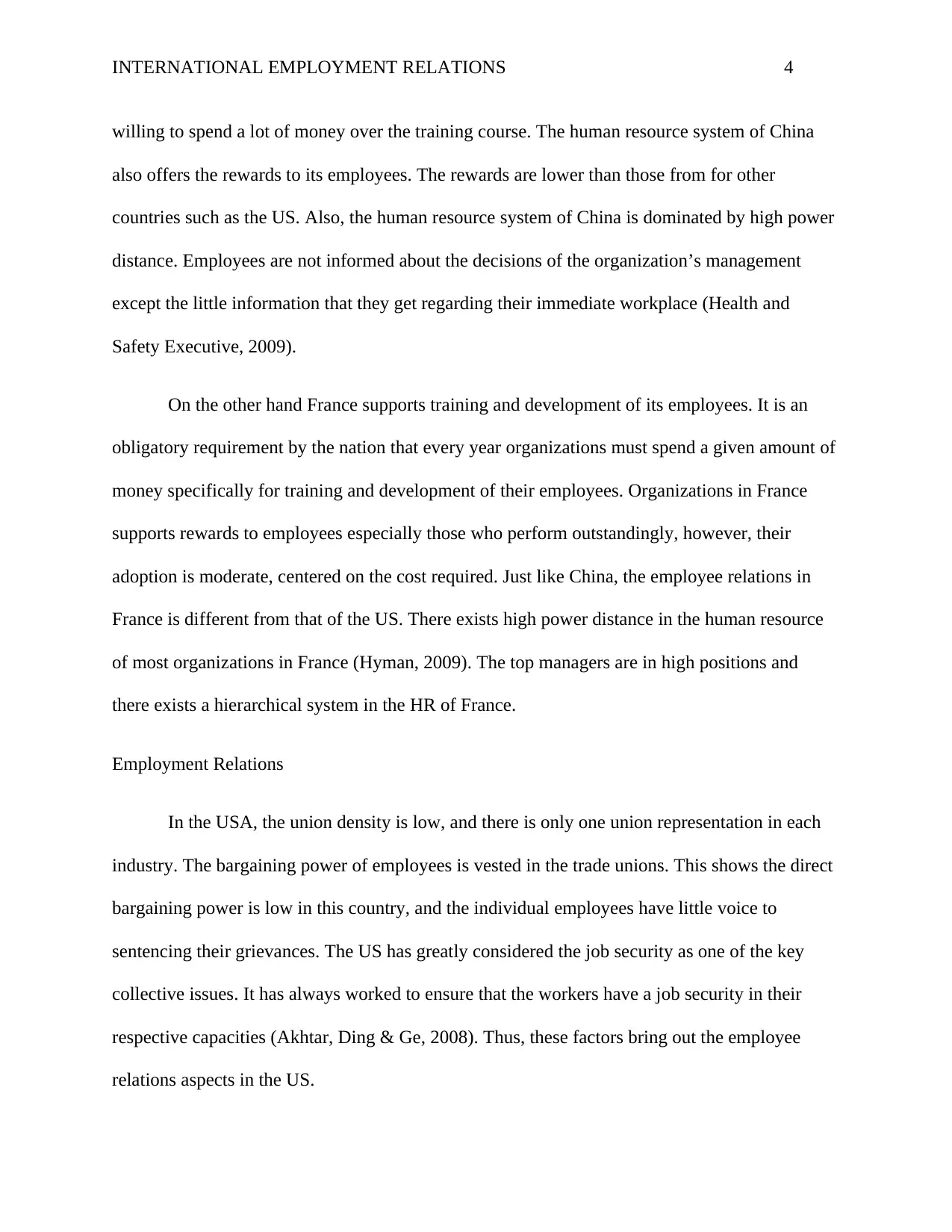
INTERNATIONAL EMPLOYMENT RELATIONS 4
willing to spend a lot of money over the training course. The human resource system of China
also offers the rewards to its employees. The rewards are lower than those from for other
countries such as the US. Also, the human resource system of China is dominated by high power
distance. Employees are not informed about the decisions of the organization’s management
except the little information that they get regarding their immediate workplace (Health and
Safety Executive, 2009).
On the other hand France supports training and development of its employees. It is an
obligatory requirement by the nation that every year organizations must spend a given amount of
money specifically for training and development of their employees. Organizations in France
supports rewards to employees especially those who perform outstandingly, however, their
adoption is moderate, centered on the cost required. Just like China, the employee relations in
France is different from that of the US. There exists high power distance in the human resource
of most organizations in France (Hyman, 2009). The top managers are in high positions and
there exists a hierarchical system in the HR of France.
Employment Relations
In the USA, the union density is low, and there is only one union representation in each
industry. The bargaining power of employees is vested in the trade unions. This shows the direct
bargaining power is low in this country, and the individual employees have little voice to
sentencing their grievances. The US has greatly considered the job security as one of the key
collective issues. It has always worked to ensure that the workers have a job security in their
respective capacities (Akhtar, Ding & Ge, 2008). Thus, these factors bring out the employee
relations aspects in the US.
willing to spend a lot of money over the training course. The human resource system of China
also offers the rewards to its employees. The rewards are lower than those from for other
countries such as the US. Also, the human resource system of China is dominated by high power
distance. Employees are not informed about the decisions of the organization’s management
except the little information that they get regarding their immediate workplace (Health and
Safety Executive, 2009).
On the other hand France supports training and development of its employees. It is an
obligatory requirement by the nation that every year organizations must spend a given amount of
money specifically for training and development of their employees. Organizations in France
supports rewards to employees especially those who perform outstandingly, however, their
adoption is moderate, centered on the cost required. Just like China, the employee relations in
France is different from that of the US. There exists high power distance in the human resource
of most organizations in France (Hyman, 2009). The top managers are in high positions and
there exists a hierarchical system in the HR of France.
Employment Relations
In the USA, the union density is low, and there is only one union representation in each
industry. The bargaining power of employees is vested in the trade unions. This shows the direct
bargaining power is low in this country, and the individual employees have little voice to
sentencing their grievances. The US has greatly considered the job security as one of the key
collective issues. It has always worked to ensure that the workers have a job security in their
respective capacities (Akhtar, Ding & Ge, 2008). Thus, these factors bring out the employee
relations aspects in the US.
Paraphrase This Document
Need a fresh take? Get an instant paraphrase of this document with our AI Paraphraser
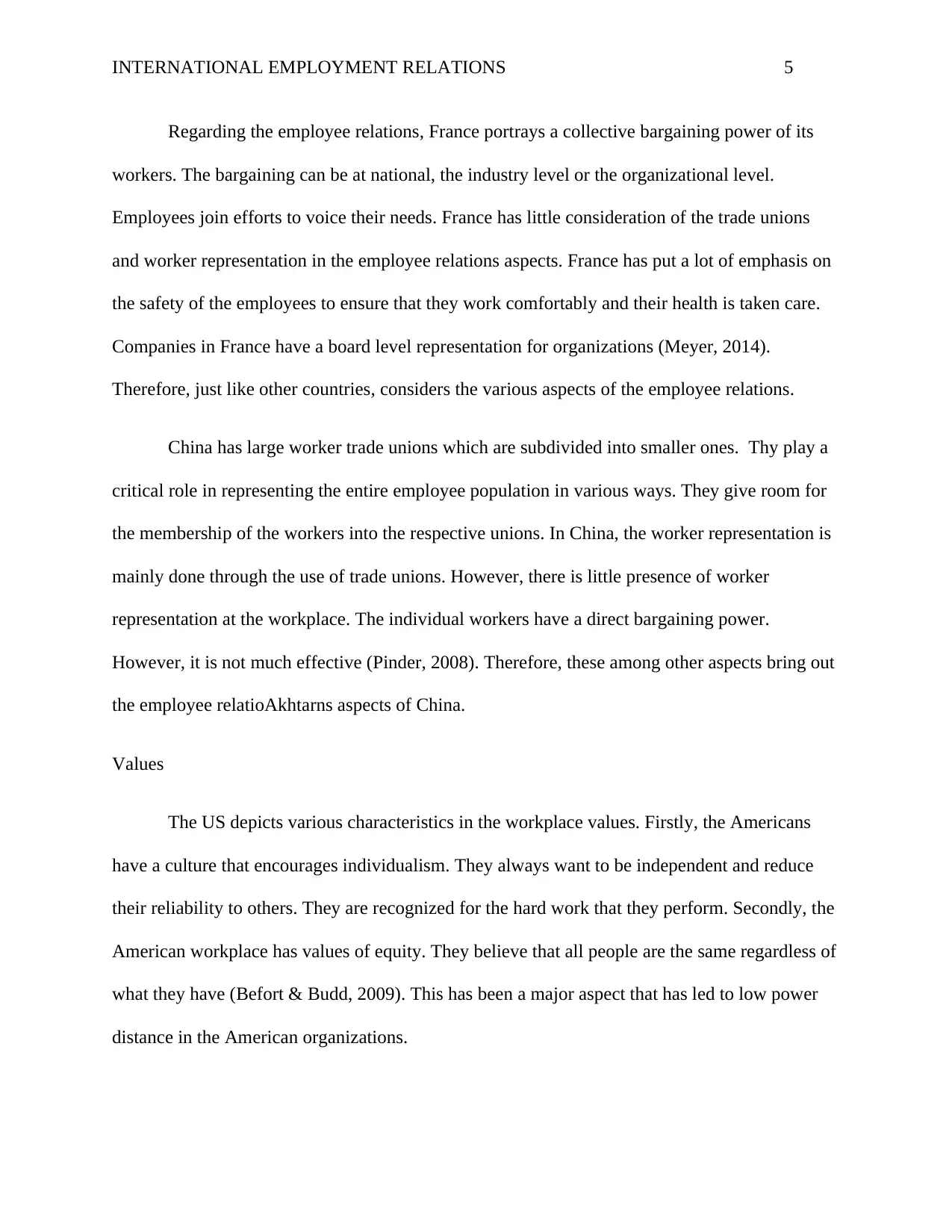
INTERNATIONAL EMPLOYMENT RELATIONS 5
Regarding the employee relations, France portrays a collective bargaining power of its
workers. The bargaining can be at national, the industry level or the organizational level.
Employees join efforts to voice their needs. France has little consideration of the trade unions
and worker representation in the employee relations aspects. France has put a lot of emphasis on
the safety of the employees to ensure that they work comfortably and their health is taken care.
Companies in France have a board level representation for organizations (Meyer, 2014).
Therefore, just like other countries, considers the various aspects of the employee relations.
China has large worker trade unions which are subdivided into smaller ones. Thy play a
critical role in representing the entire employee population in various ways. They give room for
the membership of the workers into the respective unions. In China, the worker representation is
mainly done through the use of trade unions. However, there is little presence of worker
representation at the workplace. The individual workers have a direct bargaining power.
However, it is not much effective (Pinder, 2008). Therefore, these among other aspects bring out
the employee relatioAkhtarns aspects of China.
Values
The US depicts various characteristics in the workplace values. Firstly, the Americans
have a culture that encourages individualism. They always want to be independent and reduce
their reliability to others. They are recognized for the hard work that they perform. Secondly, the
American workplace has values of equity. They believe that all people are the same regardless of
what they have (Befort & Budd, 2009). This has been a major aspect that has led to low power
distance in the American organizations.
Regarding the employee relations, France portrays a collective bargaining power of its
workers. The bargaining can be at national, the industry level or the organizational level.
Employees join efforts to voice their needs. France has little consideration of the trade unions
and worker representation in the employee relations aspects. France has put a lot of emphasis on
the safety of the employees to ensure that they work comfortably and their health is taken care.
Companies in France have a board level representation for organizations (Meyer, 2014).
Therefore, just like other countries, considers the various aspects of the employee relations.
China has large worker trade unions which are subdivided into smaller ones. Thy play a
critical role in representing the entire employee population in various ways. They give room for
the membership of the workers into the respective unions. In China, the worker representation is
mainly done through the use of trade unions. However, there is little presence of worker
representation at the workplace. The individual workers have a direct bargaining power.
However, it is not much effective (Pinder, 2008). Therefore, these among other aspects bring out
the employee relatioAkhtarns aspects of China.
Values
The US depicts various characteristics in the workplace values. Firstly, the Americans
have a culture that encourages individualism. They always want to be independent and reduce
their reliability to others. They are recognized for the hard work that they perform. Secondly, the
American workplace has values of equity. They believe that all people are the same regardless of
what they have (Befort & Budd, 2009). This has been a major aspect that has led to low power
distance in the American organizations.
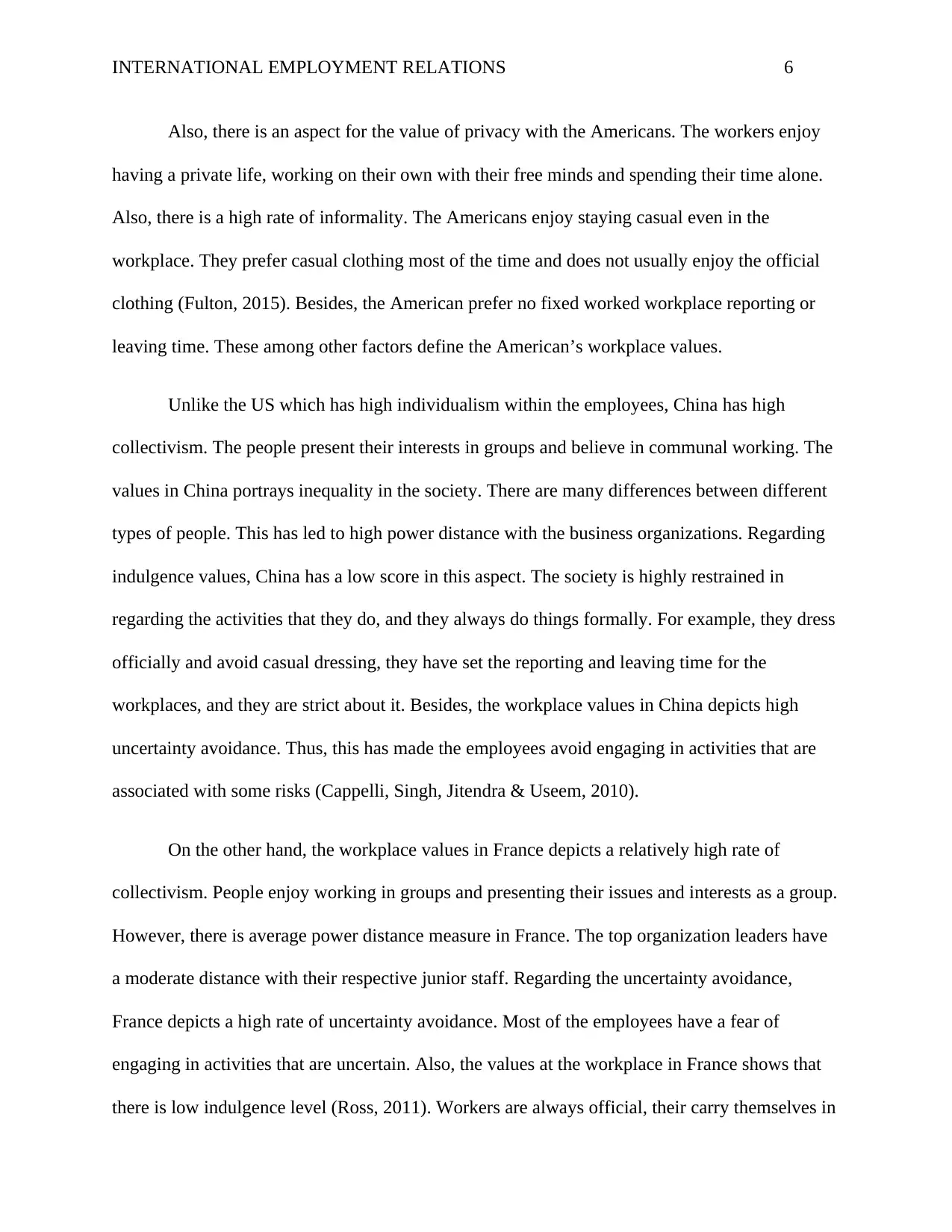
INTERNATIONAL EMPLOYMENT RELATIONS 6
Also, there is an aspect for the value of privacy with the Americans. The workers enjoy
having a private life, working on their own with their free minds and spending their time alone.
Also, there is a high rate of informality. The Americans enjoy staying casual even in the
workplace. They prefer casual clothing most of the time and does not usually enjoy the official
clothing (Fulton, 2015). Besides, the American prefer no fixed worked workplace reporting or
leaving time. These among other factors define the American’s workplace values.
Unlike the US which has high individualism within the employees, China has high
collectivism. The people present their interests in groups and believe in communal working. The
values in China portrays inequality in the society. There are many differences between different
types of people. This has led to high power distance with the business organizations. Regarding
indulgence values, China has a low score in this aspect. The society is highly restrained in
regarding the activities that they do, and they always do things formally. For example, they dress
officially and avoid casual dressing, they have set the reporting and leaving time for the
workplaces, and they are strict about it. Besides, the workplace values in China depicts high
uncertainty avoidance. Thus, this has made the employees avoid engaging in activities that are
associated with some risks (Cappelli, Singh, Jitendra & Useem, 2010).
On the other hand, the workplace values in France depicts a relatively high rate of
collectivism. People enjoy working in groups and presenting their issues and interests as a group.
However, there is average power distance measure in France. The top organization leaders have
a moderate distance with their respective junior staff. Regarding the uncertainty avoidance,
France depicts a high rate of uncertainty avoidance. Most of the employees have a fear of
engaging in activities that are uncertain. Also, the values at the workplace in France shows that
there is low indulgence level (Ross, 2011). Workers are always official, their carry themselves in
Also, there is an aspect for the value of privacy with the Americans. The workers enjoy
having a private life, working on their own with their free minds and spending their time alone.
Also, there is a high rate of informality. The Americans enjoy staying casual even in the
workplace. They prefer casual clothing most of the time and does not usually enjoy the official
clothing (Fulton, 2015). Besides, the American prefer no fixed worked workplace reporting or
leaving time. These among other factors define the American’s workplace values.
Unlike the US which has high individualism within the employees, China has high
collectivism. The people present their interests in groups and believe in communal working. The
values in China portrays inequality in the society. There are many differences between different
types of people. This has led to high power distance with the business organizations. Regarding
indulgence values, China has a low score in this aspect. The society is highly restrained in
regarding the activities that they do, and they always do things formally. For example, they dress
officially and avoid casual dressing, they have set the reporting and leaving time for the
workplaces, and they are strict about it. Besides, the workplace values in China depicts high
uncertainty avoidance. Thus, this has made the employees avoid engaging in activities that are
associated with some risks (Cappelli, Singh, Jitendra & Useem, 2010).
On the other hand, the workplace values in France depicts a relatively high rate of
collectivism. People enjoy working in groups and presenting their issues and interests as a group.
However, there is average power distance measure in France. The top organization leaders have
a moderate distance with their respective junior staff. Regarding the uncertainty avoidance,
France depicts a high rate of uncertainty avoidance. Most of the employees have a fear of
engaging in activities that are uncertain. Also, the values at the workplace in France shows that
there is low indulgence level (Ross, 2011). Workers are always official, their carry themselves in
⊘ This is a preview!⊘
Do you want full access?
Subscribe today to unlock all pages.

Trusted by 1+ million students worldwide
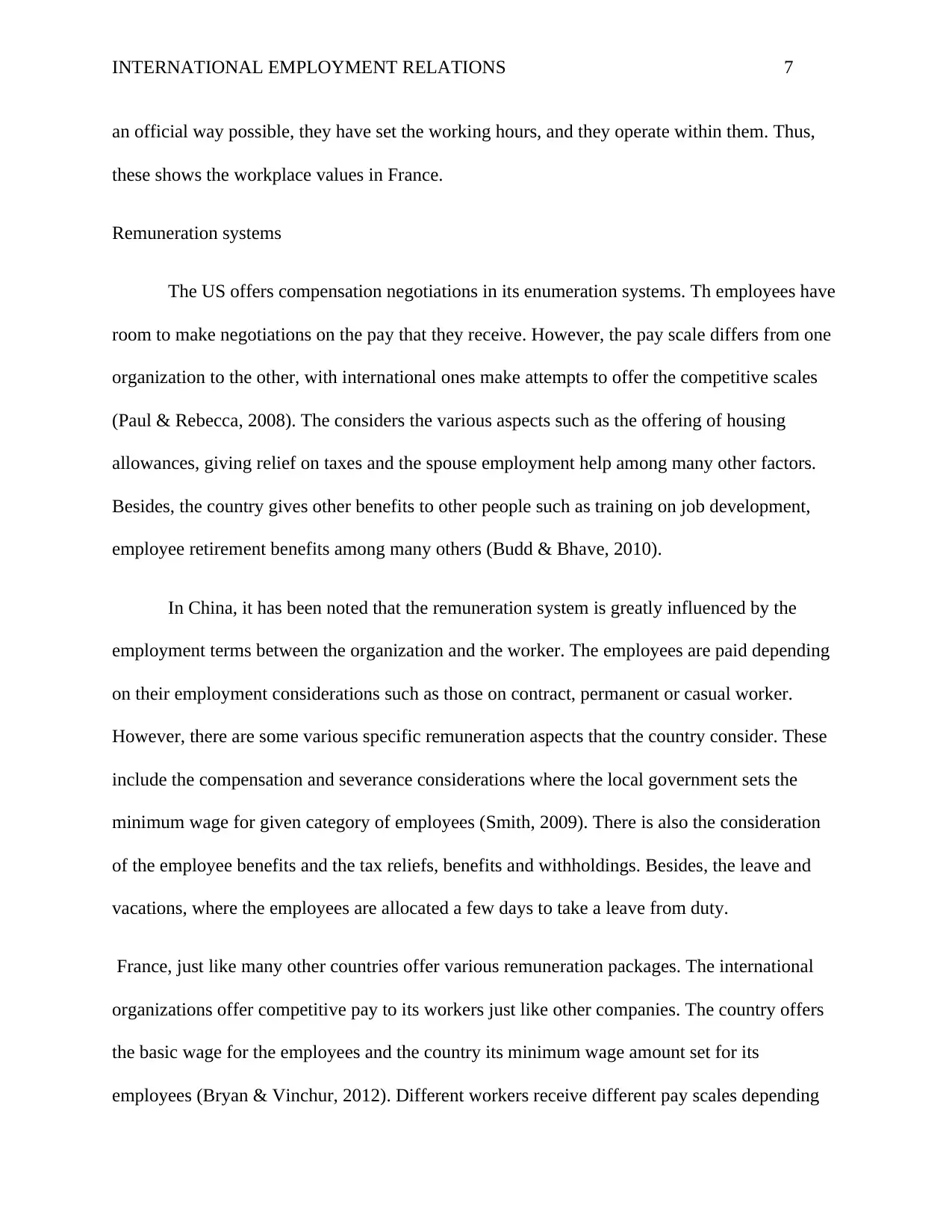
INTERNATIONAL EMPLOYMENT RELATIONS 7
an official way possible, they have set the working hours, and they operate within them. Thus,
these shows the workplace values in France.
Remuneration systems
The US offers compensation negotiations in its enumeration systems. Th employees have
room to make negotiations on the pay that they receive. However, the pay scale differs from one
organization to the other, with international ones make attempts to offer the competitive scales
(Paul & Rebecca, 2008). The considers the various aspects such as the offering of housing
allowances, giving relief on taxes and the spouse employment help among many other factors.
Besides, the country gives other benefits to other people such as training on job development,
employee retirement benefits among many others (Budd & Bhave, 2010).
In China, it has been noted that the remuneration system is greatly influenced by the
employment terms between the organization and the worker. The employees are paid depending
on their employment considerations such as those on contract, permanent or casual worker.
However, there are some various specific remuneration aspects that the country consider. These
include the compensation and severance considerations where the local government sets the
minimum wage for given category of employees (Smith, 2009). There is also the consideration
of the employee benefits and the tax reliefs, benefits and withholdings. Besides, the leave and
vacations, where the employees are allocated a few days to take a leave from duty.
France, just like many other countries offer various remuneration packages. The international
organizations offer competitive pay to its workers just like other companies. The country offers
the basic wage for the employees and the country its minimum wage amount set for its
employees (Bryan & Vinchur, 2012). Different workers receive different pay scales depending
an official way possible, they have set the working hours, and they operate within them. Thus,
these shows the workplace values in France.
Remuneration systems
The US offers compensation negotiations in its enumeration systems. Th employees have
room to make negotiations on the pay that they receive. However, the pay scale differs from one
organization to the other, with international ones make attempts to offer the competitive scales
(Paul & Rebecca, 2008). The considers the various aspects such as the offering of housing
allowances, giving relief on taxes and the spouse employment help among many other factors.
Besides, the country gives other benefits to other people such as training on job development,
employee retirement benefits among many others (Budd & Bhave, 2010).
In China, it has been noted that the remuneration system is greatly influenced by the
employment terms between the organization and the worker. The employees are paid depending
on their employment considerations such as those on contract, permanent or casual worker.
However, there are some various specific remuneration aspects that the country consider. These
include the compensation and severance considerations where the local government sets the
minimum wage for given category of employees (Smith, 2009). There is also the consideration
of the employee benefits and the tax reliefs, benefits and withholdings. Besides, the leave and
vacations, where the employees are allocated a few days to take a leave from duty.
France, just like many other countries offer various remuneration packages. The international
organizations offer competitive pay to its workers just like other companies. The country offers
the basic wage for the employees and the country its minimum wage amount set for its
employees (Bryan & Vinchur, 2012). Different workers receive different pay scales depending
Paraphrase This Document
Need a fresh take? Get an instant paraphrase of this document with our AI Paraphraser
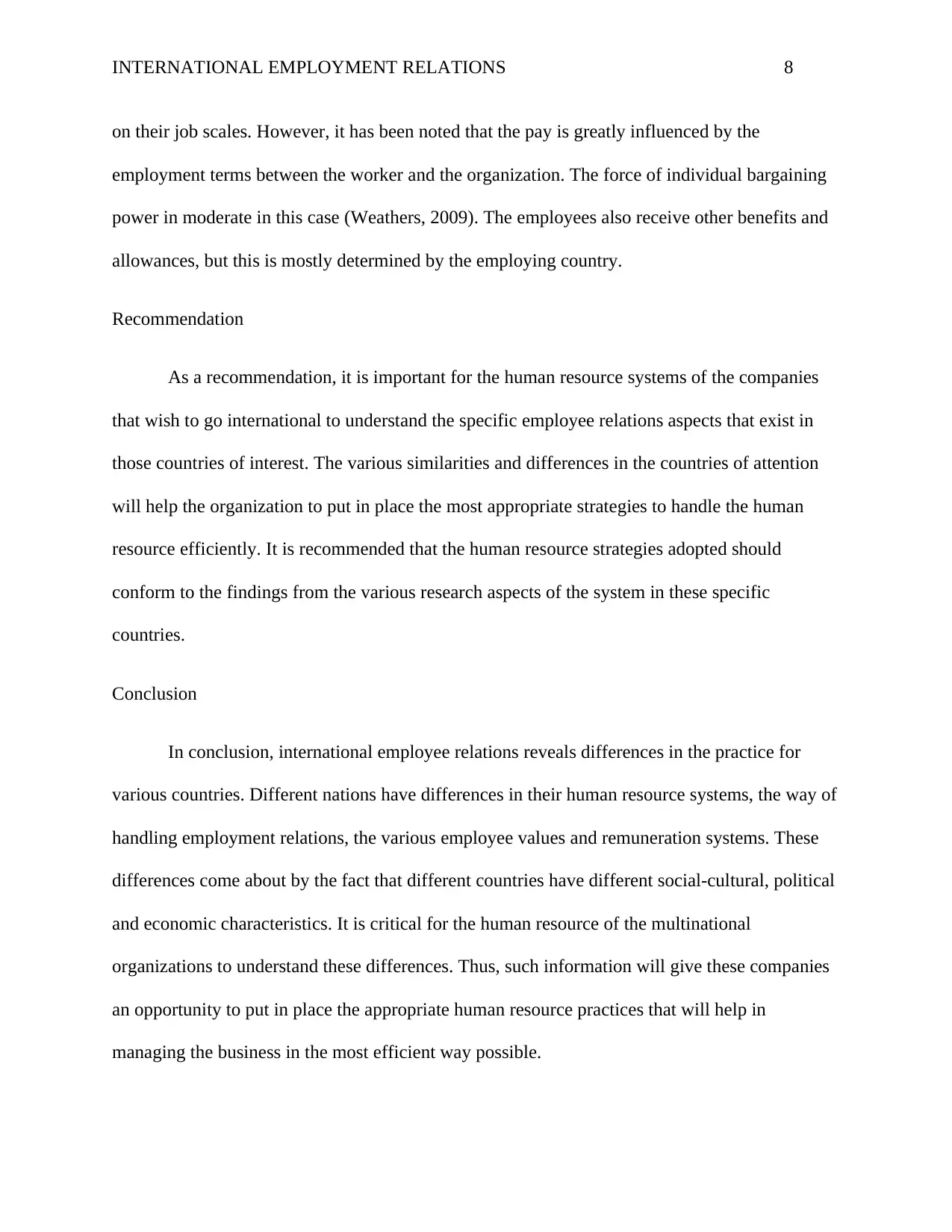
INTERNATIONAL EMPLOYMENT RELATIONS 8
on their job scales. However, it has been noted that the pay is greatly influenced by the
employment terms between the worker and the organization. The force of individual bargaining
power in moderate in this case (Weathers, 2009). The employees also receive other benefits and
allowances, but this is mostly determined by the employing country.
Recommendation
As a recommendation, it is important for the human resource systems of the companies
that wish to go international to understand the specific employee relations aspects that exist in
those countries of interest. The various similarities and differences in the countries of attention
will help the organization to put in place the most appropriate strategies to handle the human
resource efficiently. It is recommended that the human resource strategies adopted should
conform to the findings from the various research aspects of the system in these specific
countries.
Conclusion
In conclusion, international employee relations reveals differences in the practice for
various countries. Different nations have differences in their human resource systems, the way of
handling employment relations, the various employee values and remuneration systems. These
differences come about by the fact that different countries have different social-cultural, political
and economic characteristics. It is critical for the human resource of the multinational
organizations to understand these differences. Thus, such information will give these companies
an opportunity to put in place the appropriate human resource practices that will help in
managing the business in the most efficient way possible.
on their job scales. However, it has been noted that the pay is greatly influenced by the
employment terms between the worker and the organization. The force of individual bargaining
power in moderate in this case (Weathers, 2009). The employees also receive other benefits and
allowances, but this is mostly determined by the employing country.
Recommendation
As a recommendation, it is important for the human resource systems of the companies
that wish to go international to understand the specific employee relations aspects that exist in
those countries of interest. The various similarities and differences in the countries of attention
will help the organization to put in place the most appropriate strategies to handle the human
resource efficiently. It is recommended that the human resource strategies adopted should
conform to the findings from the various research aspects of the system in these specific
countries.
Conclusion
In conclusion, international employee relations reveals differences in the practice for
various countries. Different nations have differences in their human resource systems, the way of
handling employment relations, the various employee values and remuneration systems. These
differences come about by the fact that different countries have different social-cultural, political
and economic characteristics. It is critical for the human resource of the multinational
organizations to understand these differences. Thus, such information will give these companies
an opportunity to put in place the appropriate human resource practices that will help in
managing the business in the most efficient way possible.
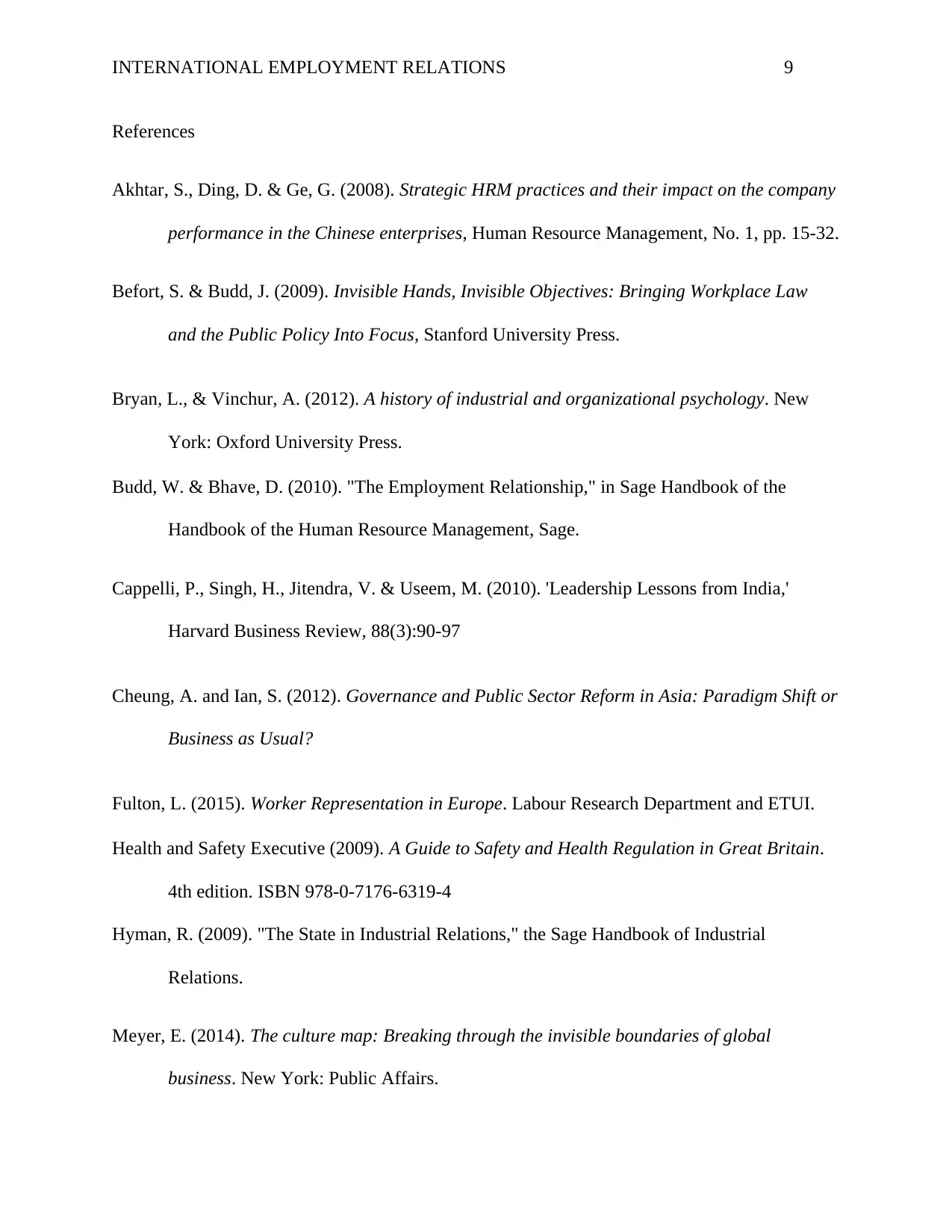
INTERNATIONAL EMPLOYMENT RELATIONS 9
References
Akhtar, S., Ding, D. & Ge, G. (2008). Strategic HRM practices and their impact on the company
performance in the Chinese enterprises, Human Resource Management, No. 1, pp. 15-32.
Befort, S. & Budd, J. (2009). Invisible Hands, Invisible Objectives: Bringing Workplace Law
and the Public Policy Into Focus, Stanford University Press.
Bryan, L., & Vinchur, A. (2012). A history of industrial and organizational psychology. New
York: Oxford University Press.
Budd, W. & Bhave, D. (2010). "The Employment Relationship," in Sage Handbook of the
Handbook of the Human Resource Management, Sage.
Cappelli, P., Singh, H., Jitendra, V. & Useem, M. (2010). 'Leadership Lessons from India,'
Harvard Business Review, 88(3):90-97
Cheung, A. and Ian, S. (2012). Governance and Public Sector Reform in Asia: Paradigm Shift or
Business as Usual?
Fulton, L. (2015). Worker Representation in Europe. Labour Research Department and ETUI.
Health and Safety Executive (2009). A Guide to Safety and Health Regulation in Great Britain.
4th edition. ISBN 978-0-7176-6319-4
Hyman, R. (2009). "The State in Industrial Relations," the Sage Handbook of Industrial
Relations.
Meyer, E. (2014). The culture map: Breaking through the invisible boundaries of global
business. New York: Public Affairs.
References
Akhtar, S., Ding, D. & Ge, G. (2008). Strategic HRM practices and their impact on the company
performance in the Chinese enterprises, Human Resource Management, No. 1, pp. 15-32.
Befort, S. & Budd, J. (2009). Invisible Hands, Invisible Objectives: Bringing Workplace Law
and the Public Policy Into Focus, Stanford University Press.
Bryan, L., & Vinchur, A. (2012). A history of industrial and organizational psychology. New
York: Oxford University Press.
Budd, W. & Bhave, D. (2010). "The Employment Relationship," in Sage Handbook of the
Handbook of the Human Resource Management, Sage.
Cappelli, P., Singh, H., Jitendra, V. & Useem, M. (2010). 'Leadership Lessons from India,'
Harvard Business Review, 88(3):90-97
Cheung, A. and Ian, S. (2012). Governance and Public Sector Reform in Asia: Paradigm Shift or
Business as Usual?
Fulton, L. (2015). Worker Representation in Europe. Labour Research Department and ETUI.
Health and Safety Executive (2009). A Guide to Safety and Health Regulation in Great Britain.
4th edition. ISBN 978-0-7176-6319-4
Hyman, R. (2009). "The State in Industrial Relations," the Sage Handbook of Industrial
Relations.
Meyer, E. (2014). The culture map: Breaking through the invisible boundaries of global
business. New York: Public Affairs.
⊘ This is a preview!⊘
Do you want full access?
Subscribe today to unlock all pages.

Trusted by 1+ million students worldwide
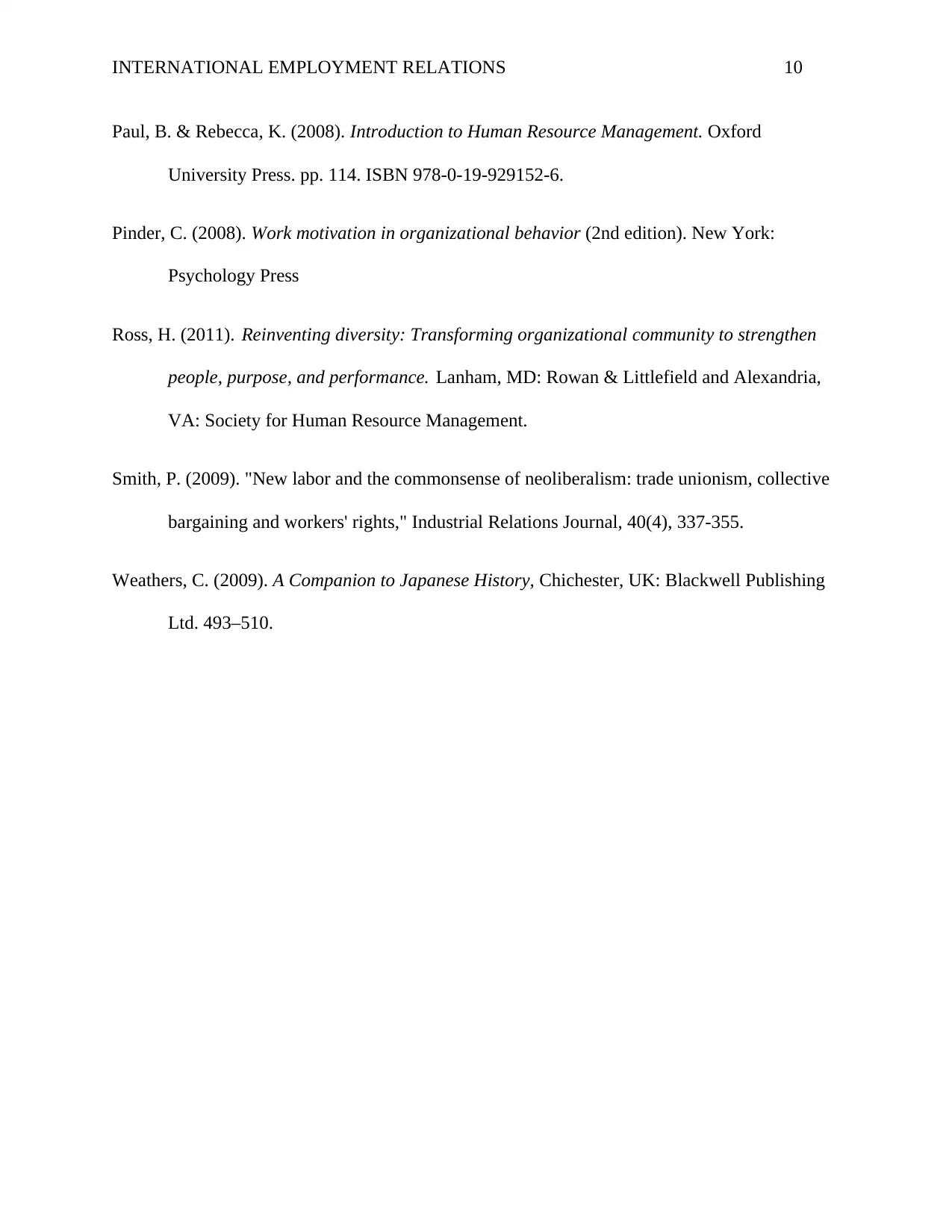
INTERNATIONAL EMPLOYMENT RELATIONS 10
Paul, B. & Rebecca, K. (2008). Introduction to Human Resource Management. Oxford
University Press. pp. 114. ISBN 978-0-19-929152-6.
Pinder, C. (2008). Work motivation in organizational behavior (2nd edition). New York:
Psychology Press
Ross, H. (2011). Reinventing diversity: Transforming organizational community to strengthen
people, purpose, and performance. Lanham, MD: Rowan & Littlefield and Alexandria,
VA: Society for Human Resource Management.
Smith, P. (2009). "New labor and the commonsense of neoliberalism: trade unionism, collective
bargaining and workers' rights," Industrial Relations Journal, 40(4), 337-355.
Weathers, C. (2009). A Companion to Japanese History, Chichester, UK: Blackwell Publishing
Ltd. 493–510.
Paul, B. & Rebecca, K. (2008). Introduction to Human Resource Management. Oxford
University Press. pp. 114. ISBN 978-0-19-929152-6.
Pinder, C. (2008). Work motivation in organizational behavior (2nd edition). New York:
Psychology Press
Ross, H. (2011). Reinventing diversity: Transforming organizational community to strengthen
people, purpose, and performance. Lanham, MD: Rowan & Littlefield and Alexandria,
VA: Society for Human Resource Management.
Smith, P. (2009). "New labor and the commonsense of neoliberalism: trade unionism, collective
bargaining and workers' rights," Industrial Relations Journal, 40(4), 337-355.
Weathers, C. (2009). A Companion to Japanese History, Chichester, UK: Blackwell Publishing
Ltd. 493–510.
1 out of 10
Related Documents
Your All-in-One AI-Powered Toolkit for Academic Success.
+13062052269
info@desklib.com
Available 24*7 on WhatsApp / Email
![[object Object]](/_next/static/media/star-bottom.7253800d.svg)
Unlock your academic potential
Copyright © 2020–2025 A2Z Services. All Rights Reserved. Developed and managed by ZUCOL.





